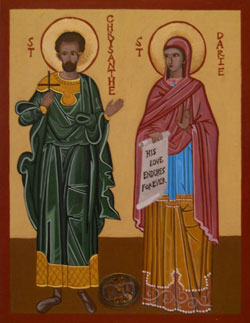
Feastday: October 25
Death: 283
Beyond the fact of his existence and martyrdom, all that is known of him is based on untrustworthy legend. An Egyptian, son of a Patrician, Polemius, he was brought to Rome from Alexandria during the reign of Numerian, and despite the objections of his father, who had brought him to Rome, was baptized by a priest named Carpophorus. Chrysanthus refused his father's attempts to get him married, finally married Daria, a Greek and a priestess of Minerva, converted her, and convinced with him in chastity. When they converted a number of Romans, Chrysanthus was denounced as a Christian to Claudius, the tribune. Chrysanthus' attitude under torture so impressed Claudius that he and his wife, Hilaria, two sons, and seventy of his soldiers became Christians, whereupon the Emperor had them all slain. Daria was sent to a brothel, where she was defended by a lion, brought before Numerian, who ordered her execution, was stoned and then buried alive. When several followers of Chrysanthus and Daria were found praying at their crypt, among them Diodorus, a priest, and Marianus, a deacon, they were all entombed alive. St. Chrysanthus' feast day is October 25.
 A column made of calc-sinter ("Eifel-Marmor"), in the church St. Chrysanthus und Daria, Bad Münstereifel, Germany.
A column made of calc-sinter ("Eifel-Marmor"), in the church St. Chrysanthus und Daria, Bad Münstereifel, Germany.
Saints Chrysanthus and Daria (3rd century – c. 283) are saints of the Early Christian period. Their names appear in the Martyrologium Hieronymianum, an early martyrs list, and a church was built in their honour over their reputed burial place in Rome.
Legend
Acts of the Martyrs relating the legend of Chrysanthus and Daria exist in a Greek and in Latin versions, dating from the fifth century and all "without historical value", according to Johann Peter Kirsch, writing in the Catholic Encyclopedia.
According to legend, Chrysanthus was the only son of an Egyptian patrician, named Polemius or Poleon, who lived during the reign of Numerian. His father moved from Alexandria to Rome. Chrysanthus was educated in the finest manner of the era. Disenchanted with the excess in the Roman world, he began reading the Acts of the Apostles.
He was then baptized and educated in Christian thinking by a priest named Carpophorus. His father was unhappy with Chrysanthus's conversion and attempted to inculcate secular ways into his son by arranging a marriage to Daria, a Roman priestess of Minerva. (Other accounts state that she was a Vestal Virgin.) Chrysanthus managed to convert his wife, and the couple agreed to lead celibate lives. They went on to convert a number of Romans.
When this was made known to Claudius, the tribune, Chrysanthus was arrested and tortured. Chrysanthus's faith and fortitude under torture were so impressive to Claudius that he and his wife, Hilaria, two sons named Maurus and Jason, and seventy of his soldiers became Christians. For this betrayal, the emperor had Claudius drowned, his sons beheaded and his wife went to the gallows. The legend states that Daria was sent to live as a prostitute, but her chastity was defended by a lioness. She was brought before Numerian and ordered to be executed. There are many variations to this legend. Some claim that she was subjected to execution by stoning, others say she was beheaded and yet others claim she was buried alive in a deep pit beside her husband. It appears this torment was chosen in order to inflict on Daria the death reserved for unfaithful vestals. They were entombed in a sand pit near the Via Salaria Nova, the catacombs in Rome.
The surviving "Acts" of Chrysanthus and Daria state that on the anniversary of their deaths, a large number of Christians had gathered at their underground crypt to pay their respects when Roman persecutors surprised them, filled the crypt with stones and buried them all alive, including Diodorus, a priest, and Marianus, a deacon.
Historicity
In 2011 a scientific investigation of the bodies, conducted by a group of scholars coordinated by Ezio Fulcheri, paleopathologist at the University of Genoa, highlighted the compatibility of the finds with the story handed down by tradition. Radiocarbon dating reveals that the remains of the two young men, a male between the age of 17 and 18 and a female between 20 and 25, date back to an era of between 80 and 340 .C. A high concentration of lead was found in the bones, a sign of their origin from the wealthy classes who had running water in the houses (conducted by lead pipes). None of the bodies also show signs of violence or illness, so the cause of death could be compatible with suffocation.
Relics
At least three places claim to possess the remains of Chrysanthus and Daria. In the ninth century, their reputed remains were brought to Prüm in modern-day Rhineland-Palatinate, and these relics are presently in the church of Chrysanthus and Daria, Bad Münstereifel, Germany. In 1011, Pope Sergius IV gave Fulk III, Count of Anjou, the reputed bodies of Chrysanthus and Daria upon his return from a pilgrimage to Jerusalem. Fulk gave them to the monastery of Belli Locus (now Beaulieu-lès-Loches), which he had recently established. The cathedral of Reggio Emilia in northern Italy also contains relics reputed to be those of Daria and Chrysanthus. A scientific study of some of the bones there confirmed that they were those of a young man and a young woman in their late teens, with a radiocarbon date between 80 and 340.





